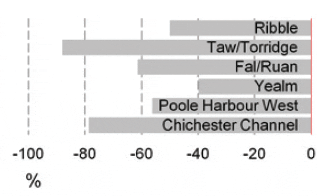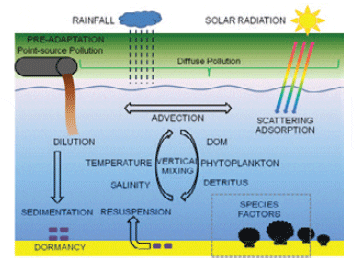Background
During filter-feeding, bivalves accumulate
bacteria and viruses from the water column
which can be pathogenic to humans. These
pathogens are commonly introduced into
the marine environment via runoff from
land affected by livestock farming and the
discharge of sewage from sewage treatment
works (STWs) and intermittent discharges
(IDs) (combined sewer overflows, storm
overflows and emergency discharges) to watercourses
within the catchment or directly
to the fishery. The accumulation of microbial
contaminants by shellfish is not only a human
health issue but also an indication of the
health status of the ecosystem as a whole.
Over recent decades, UK water companies
have made substantial investments to
reduce the impact of sewage discharges and
diffuse pollution from agriculture on the quality
of shellfish waters.
In 2009, Defra funded an investigation of
the sanitary profiles of seven shellfish water
catchments and a comprehensive review
of site-specific factors that influence the
take-up of faecal indicator organisms (FIOs)
by shellfish. This review would enable Defra
to improve planning of remedial action in
order to ensure future protection of shellfish
waters.

Appraisal of STW improvements
Faecal indicator organism (FIO) loads
(number per unit time) were quantified for
seven shellfish water catchments covering
different levels of sewerage improvements.
In six of these catchments (the exception being
the Conwy), the improvements involved
installation of ultra-violet (UV) disinfection
(tertiary treatment) in one or more STWs
over the period 20002010 (AMP3/4). In five
catchments (the exceptions being Conwy
and Chichester Channel), the improvements
also involved increase in storage capacity
and installation of screens in one or more
IDs. These studies were largely based on
generic and modelled data and on specific
assumptions made with regard to volumes of
ID flow pre- and post-improvement. Results
showed substantial reductions in FIO loads
after sewerage improvements with the biggest
estimated reductions in the Taw/Torridge
and the smallest in the Yealm (Figure 1).
In the six catchments where improvements
were made to key STWs, treated
sewage effluents from these works now
contribute <0.6% to the total FIO loads
impacting on the shellfish waters.
In the five catchments where IDs have
been improved, then, on the assumption of
a 90% reduction in the estimated volume of ID flow following improvement, the IDs
post-improvement contribute only small
proportions (< 7.0%) of the total FIO fluxes.
However, under a worst-case scenario in
which estimated ID flow volumes are greater
pre-improvement and are reduced by only
50% following improvement, ID contributions
increase to > 50%.
The impacts of sewerage and agriculturerelated
sources of pollution impacting on
shellfish waters were also estimated.
With the exception of Chichester Channel,
(where no improvements have been
made to the emergency discharges associated
with the STWs at which UV-disinfection
had been installed and IDs are estimated
to account for 99% of the FIO loads), these
studies indicated that catchments are
impacted by a combination of pollution
sources (Figure 2). These results support the
dual focus on addressing point and diffuse
sources of pollution (see Davies et al. 2010,
Shellfish News 29).

Factors influencing FIO accumulation by shellfish
The survival of microbial pathogens in seawater is influenced by a combination of environmental factors (Figure 3).

A review of the scientific literature on
these effects revealed that the highest rates
of bacterial elimination occur when solar
radiation is high, sewage content is low, mixing
conditions in the water column are high
and the levels of suspended solids in the
water are low.
Strong association was found between
salinity and FIO levels in shellfisheries. This is
because decreased salinity often indicates the
presence of fresh water which can be contaminated
with sewage and also because salinity
exerts a significant stress on bacterial cells.
For instance, salinity could be used as a proxy
for FIO contamination in the Ribble but not in
Tresillian or Yealm shellfish waters presumably
because of the lower complexity and the location of the sampling point in the former estuary
The review also demonstrated that
rainfall is the environmental parameter most
frequently cited risk factor for fluctuations
in FIO contamination in shellfish. Rainfall effects
depend on the magnitude of the event
and the characteristics of the catchment.
Using the Yealm Estuary as case study, it
was discussed that rainfall-induced peak FIO
concentrations could persist in shellfish flesh
as much as 6 days after the rainfall event.
Different species of shellfish behave
differently to these environmental factors.
Usually, mussels and cockles accumulate
microbial contaminants to higher level than
oysters. However, site-specific differences
in water:flesh FIO ratios occur because temperatures
and salinities significantly higher or
lower than the optimum for the species may
reduce pumping action of the bivalves, with
the animals ceasing filtration activity and
closing at extremely high or low levels. Occasional
events of water temperatures and
salinities outside the minimum for shellfish
growth were identified in UK estuaries.
Association between E. coli in shellfish and water
The relationship between levels of E. coli in shellfish flesh and overlying waters was studied using paired water and shellfish samples collected from 40 monitoring points within 6 production areas in England and Wales collected over the period 19911994. The resulting statistical models could be used to predict E. coli concentrations in the water on the basis of levels quantified in shellfish flesh as part of regulatory assessments. They could also be used to predict shellfish flesh quality in the event of a sewage discharge. However, only 35% of the variance in E. coli levels in shellfish flesh was explained by the variation of the indicator in the water. The lack of a clear linear relationship is in accordance with the past research in this field which has not produced credible mathematical relationships linking water quality and shellfish flesh concentrations. These studies would however help Defra understand the levels of water quality necessary to protect shellfish beds when the Shellfish Waters Directive is revoked by the Water Framework Directive in the UK in 2013. Further work is being undertaken by Cefas and CREH to refine the models using more up-to-date E. coli data.
Research highlights
In recent years, there has been considerable
progress in reducing average levels of FIOs
in shellfisheries.
In many catchments, these reductions
were associated with major sewerage infrastructure
improvements involving installation
of UV disinfection, elimination of crude
sewage discharges and reduction in the
frequency of sewage spills from IDs.
Effluents from UV disinfected plants
nowadays contribute with very low levels of
FIOs to shellfish waters.
Currently, the main sources of FIOs are
STWs that have not been improved, IDs and
diffuse pollution from agricultural land.
During high-flow conditions, under the
worst-case scenario investigated, IDs may
contribute over 50% of the total FIO load to
shellfish waters.
Favourable conditions for FIO survival
are low solar radiation, low temperature, low
salinity, low density of micro-predators and
high levels of organic matter.
Extreme temperatures and salinities may
affect the filter-feeding activity of shellfish
and alter shellfish:water FIO ratios between
fisheries.
Elevated levels of FIOs may persist in
shellfish flesh as much as 6 days after a
rainfall event.
July 2012



